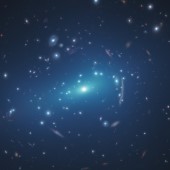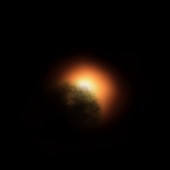ESA Science & Technology - News Archive
News archive
News archive
ESA has released its first Solar Orbiter data to the scientific community and the wider public. The instruments contributing to this data release come from the suite of in-situ instruments that measure the conditions surrounding the spacecraft.
ESA's Rosetta mission has revealed a unique kind of aurora, an exciting phenomenon seen throughout the Solar System, at its target comet, Comet 67P/Churyumov-Gerasimenko.
This latest image of Jupiter, taken by the NASA/ESA Hubble Space Telescope on 25 August 2020, was captured when the planet was 653 million kilometres from Earth.
Observations by the NASA/ESA Hubble Space Telescope and the European Southern Observatory's Very Large Telescope (VLT) in Chile have found that something may be missing from the theories of how dark matter behaves.
Save the date: the Gaia Early Data Release 3 (EDR3) will be published on 3 December 2020 at 12:00 CET. The full Gaia Data Release 3 is expected in the first half of 2022. For all details about the Gaia EDR3 see the dedicated overview page linked from here.
The NASA/ESA Hubble Space Telescope has captured the closest images yet of the sky's latest visitor to make the headlines, comet C/2020 F3 NEOWISE, after it passed by the Sun. The new images of the comet were taken on 8 August and feature the visitor's coma, the fine shell that surrounds its nucleus, and its dusty output.
Proposals are solicited for observations with XMM-Newton in response to the twentieth Announcement of Opportunity, AO-20, issued 18 August 2020. This AO covers the period May 2021 to April 2022 and is open to proposers from all over the world. The deadline for proposal submission is 9 October 2020, 12:00 UTC.
New observations by the NASA/ESA Hubble Space Telescope suggest that the unexpected dimming of the supergiant star Betelgeuse was most likely caused by an immense amount of hot material ejected into space, forming a dust cloud that blocked starlight coming from Betelgeuse's surface.
Despite a nominal lifetime of two years, ESA's Cluster is now entering its third decade in space. This four-spacecraft mission has been revealing the secrets of Earth's magnetic environment since 2000 and, with 20 years of observations under its belt, is still enabling new discoveries as it explores our planet's relationship with the Sun.
Taking advantage of a total lunar eclipse, astronomers using the NASA/ESA Hubble Space Telescope have detected ozone in Earth's atmosphere. This method serves as a proxy for how they will observe Earth-like planets around other stars in the search for life.
New research using data from multiple spacecraft, including ESA's Cluster mission, has revealed the cause behind the sudden brightening of the auroral oval before it breaks up into a substorm.
A global collaboration of telescopes including ESA's INTEGRAL high-energy space observatory has detected a unique mix of radiation bursting from a dead star in our galaxy – something that has never been seen before in this type of star, and may solve a long-standing cosmic mystery.
Proposals are invited for the CHEOPS Discretionary Programme, an element of the Guest Observers Programme which enables scientists to propose observations of individual targets that have been discovered, or declared to be of high scientific merit, since the close of AO-1 back in mid-May 2019.
The launch of the NASA/ESA/CSA James Webb Space Telescope (Webb) on an Ariane 5 rocket from Europe's Spaceport in French Guiana is now planned for 31 October 2021.
The first images from Solar Orbiter, a new Sun-observing mission by ESA and NASA, have revealed omnipresent miniature solar flares, dubbed 'campfires', near the surface of our closest star.
ESA's Euclid mission has reached another milestone on its journey towards launch. Its two instruments are now built and fully tested. These have been delivered to Airbus Defence and Space in Toulouse, France, where they are now being integrated with the telescope to form the mission's payload module.
Two studies based on ESA's Mars Express observations of Jezero crater, the future landing site for NASA's 2020 Mars Perseverance rover, have shed light on how and when this intriguing area formed – and identified the regions most likely to reveal signs of ancient life.
ESA's Solar Orbiter has successfully completed four months of painstaking technical verification, known as commissioning. Despite the challenges imposed by the COVID-19 pandemic, the spacecraft is now ready to begin performing science as it continues its cruise towards the Sun.
The young star HBC 672 is known by its nickname of Bat Shadow because of its wing-like shadow feature. The NASA/ESA Hubble Space Telescope has now observed a curious "flapping" motion in the shadow of the star's disc for the first time.
The NASA/ESA Hubble Space Telescope demonstrates its full range of imaging capabilities with two new images of planetary nebulae. The images depict two nearby young planetary nebulae, NGC 6302, dubbed the Butterfly Nebula, and NGC 7027.




















